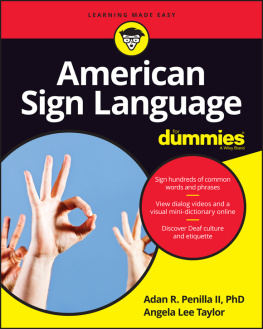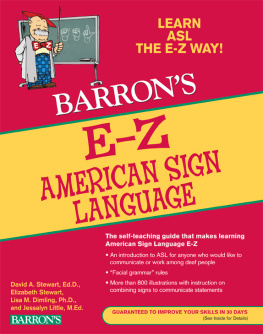
American Sign Language For Dummies
Published by: John Wiley & Sons, Inc., 111 River Street, Hoboken, NJ 07030-5774, www.wiley.com
Copyright 2017 by John Wiley & Sons, Inc., Hoboken, New Jersey
Published simultaneously in Canada
No part of this publication may be reproduced, stored in a retrieval system or transmitted in any form or by any means, electronic, mechanical, photocopying, recording, scanning or otherwise, except as permitted under Sections 107 or 108 of the 1976 United States Copyright Act, without the prior written permission of the Publisher. Requests to the Publisher for permission should be addressed to the Permissions Department, John Wiley & Sons, Inc., 111 River Street, Hoboken, NJ 07030, (201) 748-6011, fax (201) 748-6008, or online at http://www.wiley.com/go/permissions .
Trademarks: Wiley, For Dummies, the Dummies Man logo, Dummies.com, Making Everything Easier, and related trade dress are trademarks or registered trademarks of John Wiley & Sons, Inc., and may not be used without written permission. All other trademarks are the property of their respective owners. John Wiley & Sons, Inc., is not associated with any product or vendor mentioned in this book.
LIMIT OF LIABILITY/DISCLAIMER OF WARRANTY: WHILE THE PUBLISHER AND AUTHOR HAVE USED THEIR BEST EFFORTS IN PREPARING THIS BOOK, THEY MAKE NO REPRESENTATIONS OR WARRANTIES WITH RESPECT TO THE ACCURACY OR COMPLETENESS OF THE CONTENTS OF THIS BOOK AND SPECIFICALLY DISCLAIM ANY IMPLIED WARRANTIES OF MERCHANTABILITY OR FITNESS FOR A PARTICULAR PURPOSE. NO WARRANTY MAY BE CREATED OR EXTENDED BY SALES REPRESENTATIVES OR WRITTEN SALES MATERIALS. THE ADVICE AND STRATEGIES CONTAINED HEREIN MAY NOT BE SUITABLE FOR YOUR SITUATION. YOU SHOULD CONSULT WITH A PROFESSIONAL WHERE APPROPRIATE. NEITHER THE PUBLISHER NOR THE AUTHOR SHALL BE LIABLE FOR DAMAGES ARISING HEREFROM.
For general information on our other products and services, please contact our Customer Care Department within the U.S. at 877-762-2974, outside the U.S. at 317-572-3993, or fax 317-572-4002. For technical support, please visit https://hub.wiley.com/community/support/dummies .
Wiley publishes in a variety of print and electronic formats and by print-on-demand. Some material included with standard print versions of this book may not be included in e-books or in print-on-demand. If this book refers to media such as a CD or DVD that is not included in the version you purchased, you may download this material at http://booksupport.wiley.com . For more information about Wiley products, visit www.wiley.com .
Library of Congress Control Number: 2016953540
ISBN 978-1-119-28607-3 (pbk); ISBN 978-1-119-28609-7 (ebk); ISBN 978-1-119-28610-3 (ebk)
American Sign Language For Dummies
To view this book's Cheat Sheet, simply go to www.dummies.com and search for American Sign Language For Dummies Cheat Sheet in the Search box.
- Table of Contents
Guide
Pages
Introduction
American Sign Language is one of those fascinating forms of communication. As you walk through a grocery store, a restaurant, or a park, you might see some people moving their hands in the air as they look at each other. We know that they are communicating because they are responding to each other with gestures and facial expressions. There is meaning to the movement. How often have you thought that you would love to know how to do that? Well here is your chance.
About This Book
American Sign Language For Dummies is designed to give you a general understanding of how to communicate in American Sign Language, as well as a general understanding of Deaf culture and Deaf history. As youll soon see, the language and the culture go hand in hand and cant be separated, and an understanding of both makes you a better signer. As you go through this book, you will see that ASL has rules about how to shape the hands, how the hands move, and how to put signs in order.
To clarify, this book focuses solely on whats known as American Sign Language (ASL) because its pretty much the only form of communication for the Deaf community in the United States.
This book is categorized according to subject. You can use each chapter as a building block for the next chapter or you can skip around wherever you please. Just find a subject that interests you and dig in, remembering that the most important thing is to have fun while youre figuring out this stuff. It never hurts to have a study buddy. Having a friend to watch you sign, bounce off your questions, and applaud your progress may be just the thing. And if you like to fly solo, thats ok too. Whichever way you go, the construct of the book is simple enough to follow.
After you understand a concept, we strongly recommend that you practice with those who are already proficient. Conversing with Deaf people is highly recommended as they are the experts. Doing so helps reinforce the knowledge you obtain from this book and allows others to help you hone your skills. If others understand you, youre probably on the right track. And if you dont understand something, dont despair. People all over the world learn how to sign. You'll get there with practice.
Here are some conventions we use to help you navigate this book:
- We capitalize the word Sign when we use it as another name for American Sign Language. We dont, however, capitalize it when we use it as a verb (to sign) or a noun (referring to a person a signer or to a specific sign).
- We always capitalize Deaf because it means culturally Deaf (whereas lowercase deaf simply means that someone has an audiological hearing loss and communicates in spoken English rather than ASL).
- Whenever we use Sign in lists, examples, and dialogues, we print it in ALL CAPS to show that its the closest equivalent to its English counterpart.
- When we introduce a new sign, we bold it in the text so that you know youre about to learn a new sign.
- ASL doesnt use punctuation, so we add hyphens to show slight pauses in Sign translations.
- The text (Sign and its English translation) always comes before the illustration.
- To save space, manual numbers and words that are fingerspelled dont have illustrations. See if you need help remembering how to sign a particular letter or number.
- A Q in a line of ASL indicates that you need to sign the manual question mark (flip to for more on the manual question mark).
Dont think of the translations of English sentences into ASL as word-for-word translations. In fact, many signs have no English equivalents. Throughout this book, you find English equivalents that are close in meaning to Sign but not exactly the same. Remember that ASL is a completely different language from English. Fortunately, many gestures that hearing people use are also used by Deaf people in ASL, so you already have a head start that you can build on.
Foolish Assumptions
We hate to assume anything about anyone, but when writing this book, we had to make a few foolish assumptions about you. Here they are (we hope we were right):
- You have little or no experience in this type of communication, but youll try anything once. Fair is fair.
- You dont expect to become fluent in Sign after going through this book. You just want some basic vocabulary, and you want to see what particular signs look like by themselves and in simple sentences. There is nothing like intellectual curiosity.
Next page







